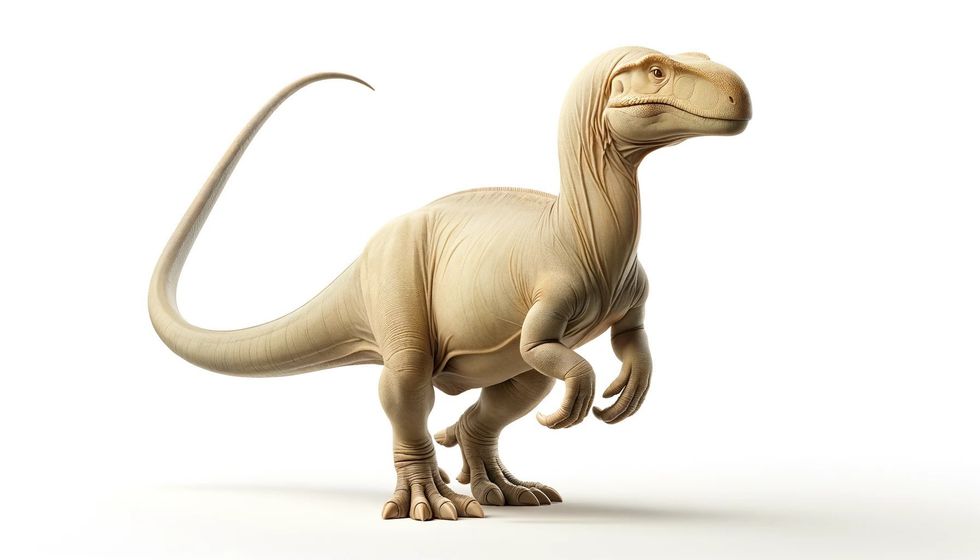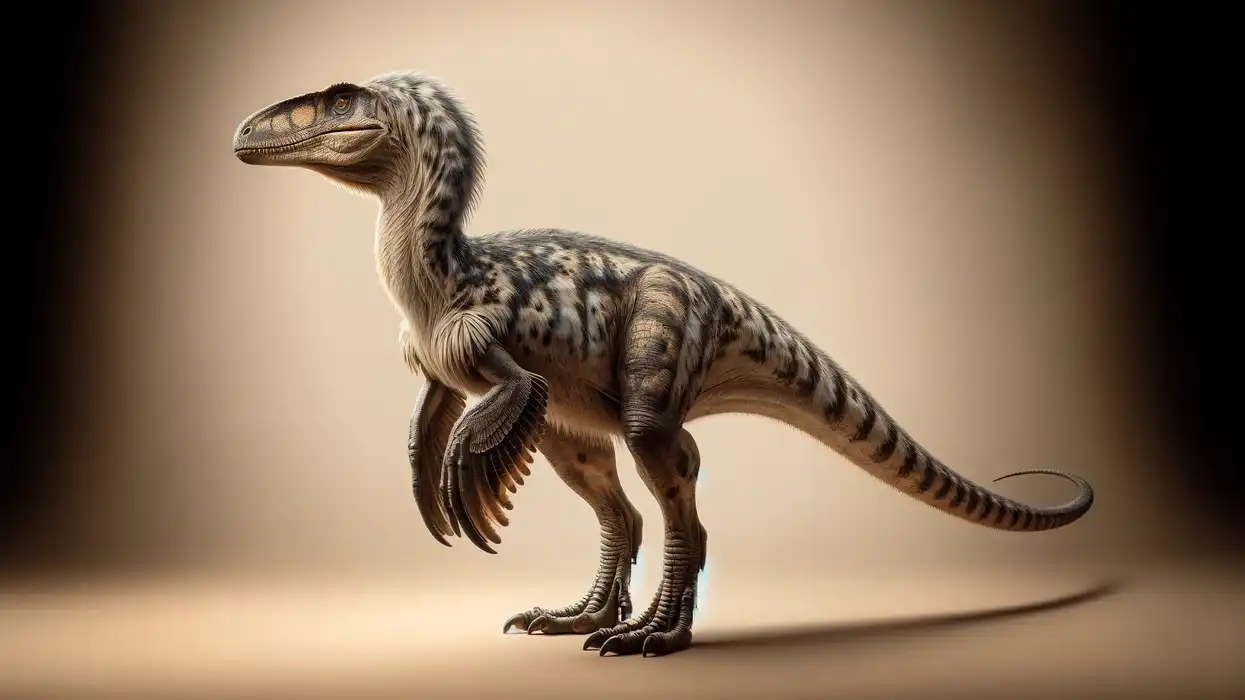The Aoniraptor is a captivating species that roamed the Earth during the Late Cretaceous Period (100.5-66 million years ago).
This two-legged meat-eater belonged to the Megaraptoridae family, known for their sharp claws and impressive hunting abilities.
While much about this dinosaur's internal anatomy remains unclear, the discovery of fossilized remains has provided insight into its extensive internal pneumatic traits and structures.
Aoniraptor Interesting Facts
How do you pronounce 'Aoniraptor'?
It is pronounced as 'Awn-ee-wrap-tor'.
What type of dinosaur was it?

The Aoniraptor, a remarkable theropod dinosaur, was a member of the Megaraptora group and was scientifically named Aoniraptor libertatem.
In which geological period did this dinosaur roam the Earth?
It roamed the Earth 96-91 million years ago during the Cenomanian age (existing around 100.5 – 93.9 million years ago) of the Late Cretaceous Period (100.5-66 million years ago).
When did Aoniraptor become extinct?
This dinosaur went extinct about 66 million years ago, around the end of the Cretaceous Period (145-66 million years ago), during the mass extinction event that affected all non-avian dinosaurs.
Where did this dinosaur live?
During the Late Cretaceous Period, it inhabited present-day Argentina, notably within the bounds of the Huincul Formation.
What was their habitat?

They resided in an area of ancient Patagonia known for its seasonal dryness. It had forests, floodplains, and rivers and streams flowing through it.
Who did they live with?
In the Huincul Formation during the Late Cretaceous, the Aoniraptor shared its environment with various dinosaurs such as carnivorous theropods, herbivorous sauropods, ornithopods, and ankylosaurs that were commonly found in South American Cretaceous ecosystems.
How long did this dinosaur live?
The lifespan of Aoniraptor, a theropod dinosaur that lived during the Late Cretaceous Period, remains a subject of speculation among paleontologists.
While there is no precise information available about its lifespan, it is believed to have been similar to that of other theropods, which could live for several decades.
However, the exact lifespan of Aoniraptor is still unknown and further research and discoveries may be required to provide more precise information.
How did they reproduce?

Similar to other known dinosaur species, the Aoniraptor reproduced by laying eggs. However, despite extensive research, understanding of their reproductive behavior remains limited.
Specific details regarding the frequency of their breeding, the size and number of eggs they laid, or the manner in which they nurtured and protected their hatchlings are not available.
Further research is required to uncover these mysteries surrounding the reproductive habits of the Aoniraptor.
Aoniraptor Fun Facts
What did they look like?
The Aoniraptor had a powerful build, with robust limbs for fast movement and hunting. Its six proximal caudal vertebrae (closest tail vertebrae) indicate a strong tail used for balance during high-speed chases.
How many bones did an Aoniraptor have?

While the exact number of bones in the Aoniraptor's skeletal structure remains unknown, scientists have been able to identify some of the prominent bones.
For instance, the sacral vertebra, located between the pelvis and tail, has been identified as one of the prominent bones. Similarly, four mid-caudal vertebrae (four middle tail bones) located in the middle of the tail have also been identified.
While there is still much to learn about the Aoniraptor, these findings represent an important step in understanding this fascinating creature.
How did they communicate?
It is unclear how Aoniraptors, the ancient dinosaur species, communicated with their peers. However, based on existing knowledge, it is possible that they employed a combination of visual displays and vocalizations to convey messages.
Additionally, the pneumatic structures within their bones may have played a role in producing sounds for communication purposes.
While further scientific research is needed to gain a comprehensive understanding of Aoniraptors' communication methods, these insights provide a glimpse into how these fascinating creatures interacted with each other.
How big was Aoniraptor?
The Aoniraptor grew up to 20 ft (6 m) in length.
How fast could this dinosaur move?
The Aoniraptor is believed to have possessed long, slender limbs that were well-adapted for swift movement, and its pneumatic bones, which were hollow and filled with air sacs, likely made it lightweight and agile.
These characteristics suggest that the Aoniraptor was capable of rapid locomotion, possibly reaching speeds that were necessary to pursue prey or evade larger predators in its environment.
Overall, the Aoniraptor was likely a highly mobile and skilled dinosaur that relied on its speed and agility to survive in its ecosystem.
How much did an Aoniraptor weigh?
Estimates suggest that Aoniraptor weighed up to 2,200 lb (1,000 kg) based on the largest known specimen.
What were the male and female names of the species?
There are no distinct terms to differentiate between the male and female members of the species. Both genders are referred to by the same species name.
This means that no observable physical differences or characteristics can be used to distinguish between male and female Aoniraptors.
What would you call a baby Aoniraptor?
Regarding baby Aoniraptors, they would typically be called hatchlings or juveniles, just like other dinosaur offspring. As with many dinosaur species, Aoniraptors likely exhibited parental care, which means that hatchlings would have required a certain level of attention from their parents to survive.
It's also possible that baby Aoniraptors had unique physical characteristics that distinguished them from adult Aoniraptors, such as different markings or proportions. However, more research would be necessary to confirm these details.
How aggressive were they?

Although there is no direct evidence of Aoniraptor's behavior, its classification as a carnivorous theropod indicates that it was likely a fierce predator that hunted other animals for food.
As a member of the theropod group, Aoniraptor had sharp teeth and claws, which were well-suited for hunting and capturing prey.
Its aggressive nature may have made it a powerful predator in its ecosystem, allowing it to compete with other carnivorous dinosaurs for resources. However, further research is required to understand its behavior and role in the environment.
Did You Know...
The Aoniraptor had an extensive pneumatic chamber (air-filled space) located within its bones, such as the sacral and caudal vertebrae, which were riddled with internal pneumatic structures. These sophisticated characteristics, like ovoid (egg-shaped) central chambers and main longitudinally (lengthwise) oriented canals, likely contributed to reducing the overall weight of the skeleton, allowing for greater agility and speed.
The presence of paired longitudinal canals and separate pneumatic canals is especially remarkable, as it highlights the evolutionary pneumatic traits that could have served multiple biological functions, including thermal regulation and respiratory efficiency.
The Aoniraptor had a fascinating set of air-filled spaces inside its body. It featured an extensive internal chamber and a system of tubes running the length of its body, known as the longitudinal internal pneumatic chamber.
These connected to a complex network called central pneumatic chamber anastomoses. One could find these amazing spaces on the front and back end, or the anterior and posterior surfaces, of its spine. Additionally, this dinosaur had special airways called dorsal and lateral canals, which helped it breathe efficiently.
FAQs
What unusual feature did this dinosaur possess within its vertebrae?
This dinosaur had a unique system of air-filled cavities in its vertebrae, suggesting highly advanced respiratory capabilities for its time.
How did the vertebrae of this dinosaur contribute to its agility?
The air-filled spaces within its vertebrae, including the extensive internal chambers and pneumatic canals, made the skeleton lighter and likely enhanced its agility and speed.
Could this dinosaur's breathing system tell us anything about its metabolism?
Yes, the complex breathing system, complete with longitudinal internal pneumatic chambers, could indicate a high metabolic rate, necessary for active predation.
Was there any significance to the configuration of this dinosaur's tail?
Indeed, the design of the tail, including features like the dorsal and lateral canals in the distal caudal vertebrae, likely played a role in balance and maneuverability.
How did the extensive internal chambers affect this dinosaur's ability to thrive in its environment?
The extensive internal chambers likely made its body lighter and could contribute to better thermoregulation, aiding its survival in a variety of environmental conditions.
What insights do the anterior and posterior surfaces of the vertebrae provide us with?
These surfaces, replete with pneumatic features, suggest a design optimized for not just breathing but also for the efficient support of muscular attachments.
How might the central pneumatic chamber anastomoses have contributed to this dinosaur's survival?
These connections between chambers allowed for a more efficient respiratory system and possibly a greater oxygen supply to muscles, aiding in prolonged activities like hunting or escaping predators.
What was the possible purpose of the separate pneumatic canals observed in this dinosaur's bones?
Separate pneumatic canals might have enhanced the efficiency of air circulation throughout the body, potentially improving respiratory and metabolic efficiency.
Did all this dinosaur's vertebrae have internal pneumatic structures?
Most of the vertebrae studied show signs of internal pneumatic structures, indicative of evolution toward optimized body mass and respiratory function.
How did the evolutionary traits of this dinosaur's pneumatic system compare to other dinosaurs?
This dinosaur's evolutionary pneumatic traits show a sophisticated level of adaptation, potentially providing insight into the diversity of respiratory adaptations among theropods.
Paleontologists are still studying the Aoniraptor, which is a fascinating species. Its unique skeletal features, such as the poorly preserved transverse processes and pneumatic foramen, continue to provide insights into the complexity of dinosaur anatomy. This offers a glimpse into the evolutionary wonders of the animal kingdom.
With only a fraction of their true majesty available, the Aoniraptor's legacy is a puzzle that science eagerly endeavors to piece together.
Related Articles Around the Web














